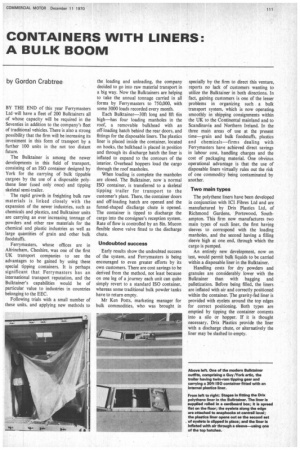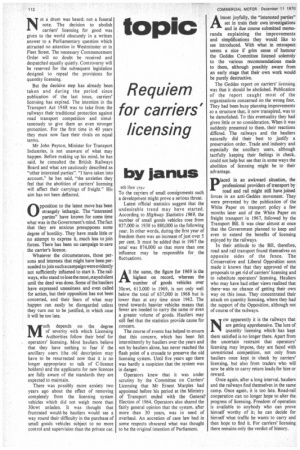CONTAINERS WITH LINERS: A BULK BOOM
Page 113

Page 114

If you've noticed an error in this article please click here to report it so we can fix it.
by Gordon Crabtree
BY THE END of this year Ferrymasters Ltd will have a fleet of 200 Bulktainers all of whose capacity will be required in the Seventies in addition to the company's fleet of traditional vehicles. There is also a strong possibility that the firm will be increasing its investment in this form of transport by a further 100 units in the not too distant future.
The Bulktainer is among the newer developments in this field of transport, consisting of an ISO container designed by York for the carrying of bulk tippable cargoes by the use of a disposable polythene liner (used only once) and tipping skeletal semi-trailer.
The rapid growth in freighting bulk raw materials is linked closely with the expansion of the newer industries, such as chemicals and plastics, and Bulktainer units are carrying an ever increasing tonnage of powders and other raw materials for the chemical and plastic industries as well as large quantities of grain and other bulk foodstuffs.
Ferrymasters, whose offices are in Akrincham, Cheshire, was one of the first UK transport companies to see the advantages to be gained by using these special tipping containers. It is perhaps significant that Ferrymasters has an international transport reputation, and the Bulktainer's capabilities would be of particular value to industries in countries belonging to the EEC.
Following trials with a small number of these units, and applying new methods to the loading and unloading, the company decided to go into raw material transport in a big way. Now the Bulktainers are helping to take the annual tonnage carried in all forms by Ferrymasters to 750,000, with some 3000 loads recorded every month.
Each Bulktainer-30ft long and 811 6in high—has four loading manholes in the roof, a removable bulkhead with an off-loading hatch behind the rear doors, and fittings for the disposable liners. The plastics liner is placed inside the container, located on hooks, the bulkhead is placed in position and through its discharge hatch the liner is inflated to expand to the contours of the interior. Overhead hoppers load the cargo through the roof manholes.
When loading is complete the manholes are closed. The Bulktainer, now a normal ISO container, is transferred to a skeletal tipping trailer for transport to the customer's plant. There, the container doors and off-loading hatch are opened and the funnel-shaped discharge chute is opened. The container is tipped to discharge the cargo into the consignee's reception system. Rate of flow is controlled by an 8in. Mucon flexible sleeve valve fitted to the discharge chute.
Undoubted success Early results show the undoubted success of the system, and Ferrymasters is being encouraged to even greater efforts by its own customers. There are cost savings to be derived from the method, not least because on one leg of a journey each unit can quite simply revert to a standard ISO container, whereas some traditional bulk powder tanks have to return empty.
Mr Ken Potts. marketing manager for bulk commodities, who was brought in specially by the firm to direct this venture, reports no lack of customers wanting to utilize the Bulktainer in both directions. In fact, gaining customers is one of the lesser problems in organizing such a bulk transport system, which is now operating smoothly in shipping consignments within the UK to the Continental mainland and to Scandinavia and Northern Ireland. In the three main areas of use at the present time—grain and bulk foodstuffs, plastics and chemicals—firms dealing with Ferrymasters have achieved direct savings in labour cost, handling charges and the cost of packaging material. One obvious operational advantage is that the use of disposable liners virtually rules out the risk of one commodity being contaminated by another.
Two main types The polythene liners have been developed in conjunction with ICI .Fibres Ltd and are manufactured by Drix Plastics Ltd, of Richmond Gardens, Portswood, Southampton. This firm now manufactures two main types of such liner, the first having sleeves to correspond with the loading manholes, and the second having a filling sleeve high at one end, through which the cargo is pumped.
An entirely new development, now on test, would permit bulk liquids to be carried within a disposable liner in the Bulktainer.
Handling costs for dry powders and granules are considerably lower with the Bulktainer than with bagging and palletization. Before being filled, the liners are inflated with air and correctly positioned within the container. The gravity-fed liner is provided with eyelets around the top edges for correct positioning. Both types are emptied by tipping the container contents into a silo or hopper. If it is thought necessary, Drix Plastics provide the liner with a discharge chute, or alternatively the liner may be slashed to empty.
Not a drum was heard; not a funeral note. The decision to abolish carriers' licensing for good was given to the world obscurely in a written answer to a Parliamentary question which attracted no attention in Westminster or in Fleet Street. The necessary Commencement Order will no doubt be received and despatched equally quietly. Controversy will be reserved for the subsequent legislation designed to repeal the provisions for quantity licensing.
But the decisive step has already been taken and during the period since publication of the last issue, carriers' licensing has expired. The intention in the Transport Act 1968 was to take from the railways their traditional protection against road transport competition and simultaneously to give them an even stronger protection. For the first time in 40 years they must now face their rivals on equal terms.
Mr John Peyton, Minister for Transport Industries, is not unaware of what may happen. Before making up his mind, he has said. he consulted the British Railways Board and what are cautiously described as "other interested parties". "I have taken into account," he has said, "the anxieties they feel that the abolition of carriers' licensing will affect their carryings of freight." His aim has not been deflected.
Opposition to the latest move has been strangely lethargic. The "interested parties" have known for some time what was in the Government's mind. The fact that they are anxious presupposes some degree of hostility. They have made little or no attempt to express it, much less to join forces. There has been no campaign to save the carrier's licence.
Whatever the circumstances, those persons and interests that might have been persuaded to join such a campaign were evidently not sufficiently inflamed to start it. The railways, who stand to lose the most, stayed silent until the deed was done. Some of the hauliers have expressed uneasiness and even called for action, but their opposition has not been concerted, and their fears of what may happen can easily be disregarded unless they turn out to be justified, in which case it will he too late.
iVluch depends on the degree of severity with which Licensing Authorities follow their brief for operators' licensing. Most hauliers believe that they have nothing to fear if the ancillary users (the old description may have to be resurrected now that it is no longer appropriate to talk of C-licence holders) and the applicants for new licences are fully aware of the standards they are expected to maintain.
There was possibly more anxiety two years ago about the effect of removing completely from the licensing system vehicles which did not weigh more than 30cw-t unladen. It was thought that frustrated would-be hauliers would see a way round their difficulty in the purchase of small goods vehicles subject to no more control and supervision than the private car.






























































































































































